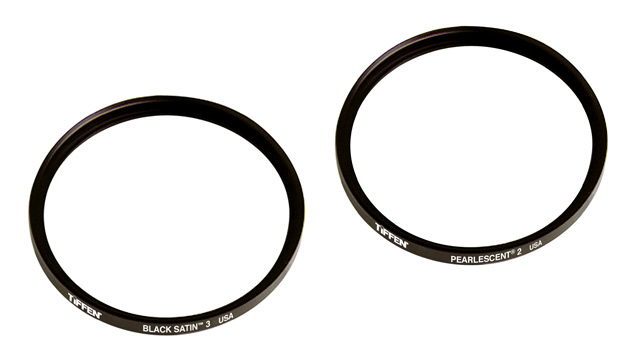Shooters of the World! Finish What You Started!
The advent of inexpensive 4K single sensor cameras, including a trove of DSLR variants, has exposed a glaring need for supplemental optical filtration. Optical filters can easily reduce noise, improve shadow and highlight integrity, and otherwise produce a more flattering image. Most shooters working with prosumer and consumer gear recognize the less-than-stellar processing in these low-cost cameras. While image quality has improved remarkably in recent models, it still leaves a lot to be desired when capturing high-motion scenes in low light or in scenes exhibiting a wide dynamic range.
For the discerning shooter, the trend among manufacturers these days to tout their cameras’ performance solely with respect to a well-illuminated static test chart just doesn’t cut it. When it comes to real-life applications, unless you’re shooting with a high-end digital cinema camera you’re probably suffering from the common curse of substandard, yet very high-resolution, images. This is despite the ballyhoo promulgated by camera makers (and many DPs) who cite 12 or more stops of latitude as proof their cameras are performing well and producing glorious, pristine pictures.
The truth is, heavy compression, the physical constraints of the sensor, and more obvious lens defects associated with middling 4K cameras (especially when recording to an internal memory card) will often produce a bevy of ugly artifacts like noisy, unsmooth shadows, brash highlights that abruptly fall off the edge, and splotchy unflattering skin tones.
Yes, some of these defects should be expected as an inexpensive camera struggles to make the best of difficult conditions. But, more often than not, the proper optical filter can mitigate the most deleterious effects of the relatively unsophisticated image processing performed by low-cost cameras. In many cases, the appropriate filter can make the difference between a first-class, truly professional-looking image and a lackluster approximation. This is because unlike post-camera filtration, which is applied to a recorded file that may already suffer severe restraints on its quality, an optical filter impacts the performance of the lens, sensor, and image processor performance directly, with the potential (in theory, at least) of optimizing the combined response.
I see the desired effect regularly in my daily work. The correct filter can significantly improve shadow integrity, reduce blocking errors, and soften the roll-off of highlights. The latter effect in particular — how your camera handles the brightest highlights in a scene — is the most salient indicator of your professional work.
Years ago, many professionals understood that a Tiffen Black Pro Mist filter could work wonders on Betacam SP CCD-equipped cameras. This understanding was so pervasive and generic that camera rental houses typically included a ½ BPM filter with their kits. The intent was to give images a more organic look and help break down the hard plastic video edge around in-focus objects.

A light Black Pro-Mist may still prove useful to match hard, modern lenses like the Zeiss CP.2 (left) to vintage optics with a pastel look, like older Switar lenses and Cooke zooms.
Today a similar understanding is required to derive the best possible images from large-format single-sensor cameras like the Sony A7 and BlackMagic URSA. However, there is a difference. Given the deeply recessed photosites of modern sensors, the large dot pattern and broad scatter from filters like the Black Pro Mist produces an unusable image. (Using such filters in the lightest grade may still prove useful to match certain type lenses, a newer series Zeiss CP.2 prime to a vintage Cooke zoom, for example.)

Older series diffusion filters like the large-dot Black Pro-Mist will wreak havoc with modern 4K sensors fitted with deep photosites. The broad scatter from such filters will produce an ugly, unusable image with severely reduced resolution and contrast. These images were captured using a Blackmagic Ursa fitted with a Canon EF 24–70mm L lens.
But newer 4K single-sensor large-format cameras can benefit handsomely from the latest generation of sharp diffusion filters that are designed from the get-go for greater telecentricity and linearity with minimal light scatter. The idea is to reach deeply into the sensor’s photosite buckets and produce images with an enhanced feel and texture, while still retaining maximum sharpness, particularly in the pupil of the eye.

Tiffen's Satin and Black Satin filters maintain sharpness in the eyes while tastefully diffusing the edges of the eye sockets and skin in the face. The effect of these filters is very subtle.
In this regard, Tiffen’s Satin and Black Satin filters produce optimal results with no indication to the viewer that a diffusion filter has been applied. Images appear unmolested, with a more integral feel and flattering finish — just what the doctor ordered when working with low- and mid-range 4K resolution cameras.

Compared to the normal Satin, the Black Satin resolves additional fine detail in the shadows and produces less flare in the whites.
For nonfiction programs and documentaries these latest-generation filters are a godsend; the Satin/Black Satin filters may be used to great advantage for even the most routine interviews without fear of producing an inappropriate and highly distracting theatrical look.

The Tiffen Pearlescent offers a similar look to the Satins but adds a glow to produce a more theatrical finish. While useful for many narrative applications, most nonfiction shooters will prefer the more subtle Satin or Black Satin. The Black Satin retains greater detail in the shadows while also producing a nice roll-off in the highlights.











Leave a Reply